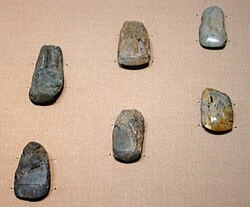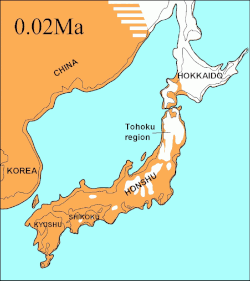Japanese Paleolithic: Difference between revisions
No edit summary |
Iridescence (talk | contribs) →Ground stone and polished tools: copyedits |
||
| Line 30: | Line 30: | ||
==Ground stone and polished tools== |
==Ground stone and polished tools== |
||
[[File:Hyogo Prefectural Museum of Archaeology07s3872.jpg|thumb|Mammoth hunt, (Hyogo Prefectural Museum of Archaeology)]] |
[[File:Hyogo Prefectural Museum of Archaeology07s3872.jpg|thumb|Mammoth hunt, (Hyogo Prefectural Museum of Archaeology)]] |
||
The Japanese Paleolithic is |
The Japanese Paleolithic is unique in that it incorporates one of the earliest known sets of [[ground stone]] and polished stone tools in the world, although older ground stone tools have been discovered in Australia.<ref>{{cite web|url=http://www.abc.net.au/news/science/2016-05-11/worlds-oldest-known-ground-edge-stone-axe-fragments-found/7401728|title=World's oldest known ground-edge stone axe fragments found in WA|author=|date=11 May 2016|website=abc.net.au|accessdate=3 April 2018}}</ref><ref>"Prehistoric Japan, New perspectives on insular East Asia", Keiji Imamura, University of Hawaii Press, Honolulu, {{ISBN|0-8248-1853-9}}</ref> The tools, which have been dated to around 30,000 BC, are a technology associated in the rest of the world with the beginning of the [[Neolithic]] around 10,000 BC. It is not known why such tools were created so early in Japan, although the period is associated with a warmer climate worldwide (30,000–20,000 BC), and the islands may have particularly benefited from it.<ref>{{cite web |url=https://heritageofjapan.wordpress.com/pacing-the-paleolithic-path/stone-age-accessories/stone-tool-inventory/types-of-chipped-stone-artifacts/stone-age-news/the-puzzle-of-the-origin-of-the-worlds-earliest-polished-stone-tools/ |title=The puzzle of tracing the origin of the world's earliest polished stone tools |publisher=heritageofjapan |date= |author= |accessdate= December 28, 2016}}</ref> |
||
Because of this originality, the Japanese Paleolithic period in Japan does not exactly match the traditional definition of [[Paleolithic]] based on [[stone technology]] ([[chipped stone]] tools). Japanese Paleolithic tool implements thus display [[Mesolithic]] and [[Neolithic]] traits as early as 30,000 BC.{{citation needed|date=April 2014}} |
Because of this originality, the Japanese Paleolithic period in Japan does not exactly match the traditional definition of [[Paleolithic]] based on [[stone technology]] ([[chipped stone]] tools). Japanese Paleolithic tool implements thus display [[Mesolithic]] and [[Neolithic]] traits as early as 30,000 BC.{{citation needed|date=April 2014}} |
||
Revision as of 08:32, 16 November 2018
| Part of a series on the |
| History of Japan |
|---|
 |

| - regions above sea level | |
| (white color) - unvegetated | |
| - sea |
The Japanese Paleolithic period (旧石器時代, kyūsekki jidai) is the period of human inhabitation in Japan predating the development of pottery, generally before 10,000 BC[1]. The starting dates commonly given to this period are from around 40,000 BC;[2] although any date of human presence before 35,000 BC is controversial, with artifacts supporting a pre-35,000 BC human presence on the archipelago being of questionable authenticity.[3] The period extended to the beginning of the Mesolithic Jōmon period, or around 14,000 BC,[4]
The earliest human bones were discovered in the city of Hamamatsu in Shizuoka Prefecture, which were determined by Radiocarbon dating to date to around 14,000–18,000 years ago.
Archaeology of the Paleolithic period
The study of the Paleolithic period in Japan was not begun until quite recently: the first Paleolithic site was not discovered until 1946, right after the end of World War II[1]. Due to the previous assumption that humans did not live in Japan before the Jōmon period, excavations usually stopped at the beginning of the Jōmon stratum (14,000 BC), and were not carried on further. However, since that first Paleolithic find by Tadahiro Aizawa, around 5,000 Paleolithic sites have been discovered, some of them at existing Jōmon archaeological sites, and some dating to the Pleistocene era. Sites have been discovered from southern Kyushu to northern Hokkaido, but most are small and only stone tools have been preserved due to the high acidity of the Japanese soil. As the Palaeolithic peoples probably occupied the wide coastal shelves exposed by lower sea levels during the Pleistocene, the majority of sites are most likely inundated.[1]
The study of the Japanese Paleolithic period is characterized by a high level of stratigraphic information due to the volcanic nature of the archipelago: large eruptions tend to cover the islands with levels of Volcanic ash, which are easily datable and can be found throughout the country as a reference. A very important such layer is the AT (Aira-Tanzawa) pumice, which covered all Japan around 21,000–22,000 years ago.
In 2000 the reputation of Japanese archaeology of the Paleolithic was heavily damaged by a scandal, which has become known as the Japanese Paleolithic hoax. The Mainichi Shimbun reported the photos in which Shinichi Fujimura, an archaeologist in Miyagi Prefecture, had been planting artifacts at the Kamitakamori site, where he "found" the artifacts the next day. He admitted the fabrication in an interview with the newspaper. The Japanese Archaeological Association disaffiliated Fujimura from its members. A special investigation team of the Association revealed that almost all the artifacts which he had found were his fabrication.
Since the discovery of the hoax, only a few sites can tentatively date human activity in Japan to 40,000–50,000 BC, and the first widely accepted date of human presence on the archipelago can be reliably dated circa 35,000 BC.[3]
Ground stone and polished tools
The Japanese Paleolithic is unique in that it incorporates one of the earliest known sets of ground stone and polished stone tools in the world, although older ground stone tools have been discovered in Australia.[5][6] The tools, which have been dated to around 30,000 BC, are a technology associated in the rest of the world with the beginning of the Neolithic around 10,000 BC. It is not known why such tools were created so early in Japan, although the period is associated with a warmer climate worldwide (30,000–20,000 BC), and the islands may have particularly benefited from it.[7]
Because of this originality, the Japanese Paleolithic period in Japan does not exactly match the traditional definition of Paleolithic based on stone technology (chipped stone tools). Japanese Paleolithic tool implements thus display Mesolithic and Neolithic traits as early as 30,000 BC.[citation needed]
Paleoanthropology
The Paleolithic populations of Japan, as well as the later Jōmon populations, appear to relate to an ancient Paleo-Asian group which occupied large parts of Asia before the expansion of the populations characteristic of today's people of China, Korea, and Japan.[8][9]
During much of this period, Japan was connected to the Asian continent by land bridges due to lower sea levels. [1] Skeletal characteristics point to many similarities with other aboriginal people of the Asian continent. Dental structures belong to the Sundadont group, mainly distributed in ancient populations of South-East Asia (where current populations belong to a mixture of Sunadont and Sinodont groups). Skull features tend to be stronger, with comparatively recessed eyes.[10]
The aboriginal populations of the Ainu, today mostly confined to the northern island of Hokkaidō, and the Ryukyuan people, mostly in southern Japan, appear to be the descendants of these Paleolithic populations, and display features that have, in the past, been interpreted as Caucasoid, but today tend to be considered more generally as part of that early Paleolithic human stock and are genetically closer to Southeast Asians.[citation needed]
Genetic analysis on today's populations is not clear-cut and tends to indicate a fair amount of genetic intermixing between the earliest populations of Japan and later arrivals (Cavalli-Sforza). It is estimated that 20 to 30% of the genetic capital of the Japanese population (Yamato people) today derives from the aboriginal Paleolithic-Jōmon ancestry, with the remainder coming from later migrations from the continent, especially during the Yayoi period.[11]
See also
- List of archaeological periods
- List of archaeological sites sorted by continent and age
- Prehistoric Asia
References
- ^ a b c d Campbell, Allen; Nobel, David S (1993). Japan: An Illustrated Encyclopedia. Kodansha. p. 1186. ISBN 406205938X.
- ^ Hoshino Iseki Museum, Tochigi Pref.
- ^ a b Prehistoric Archaeological Periods in Japan, Charles T. Keally
- ^ [1]"Ancient Jomon of Japan", Habu Jinko, Cambridge Press, 2004 [https://web.archive.org/web/20070827214726/http://www.jomon.or.jp/ebulletin11.html Archived 2007-08-27 at the Wayback Machine
- ^ "World's oldest known ground-edge stone axe fragments found in WA". abc.net.au. 11 May 2016. Retrieved 3 April 2018.
- ^ "Prehistoric Japan, New perspectives on insular East Asia", Keiji Imamura, University of Hawaii Press, Honolulu, ISBN 0-8248-1853-9
- ^ "The puzzle of tracing the origin of the world's earliest polished stone tools". heritageofjapan. Retrieved December 28, 2016.
- ^ "About Japan: A Teacher's Resource". Aboutjapan japansociety. Retrieved December 28, 2016.
- ^ "Population and Settlement - Japan: A Unique Country". Jkephartjapan weebly. Retrieved December 28, 2016.
- ^ "Origins of the Palaeolithic people of Japan". heritageofjapan. Retrieved December 28, 2016.
- ^ "Paleolithic Contingent in Modern Japanese: Estimation and Inference using Genome-wide Data : Scientific Reports". Nature com. Retrieved December 28, 2016.
Bibliography
- The History and Geography of Human Genes, Cavalli-Sforza, Princeton University Press, ISBN 0-691-08750-4
- Ainu:Spirit of a Northern People, National Museum of Natural History, Smithsonian Institution, ISBN 0-9673429-0-2
- Shoh Yamada (2002). Harvard Asia Quarterly "Politics and Personality: Japan's Worst Archaeology Scandal", Volume VI, No. 3. Summer
